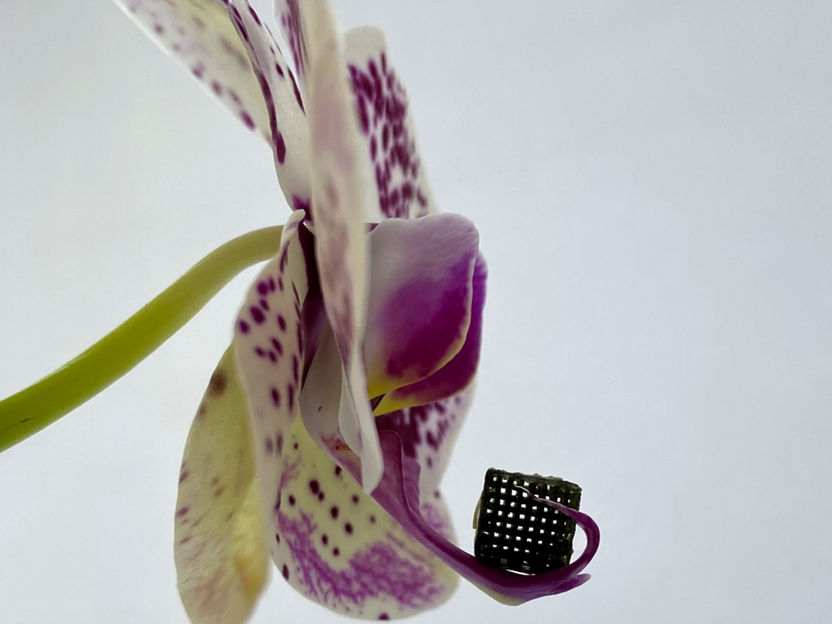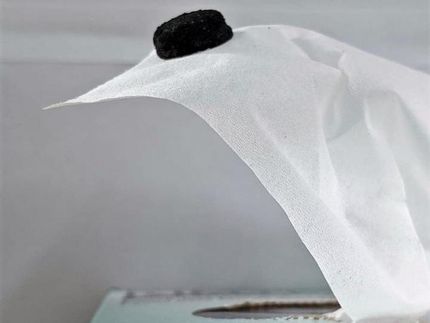3D printing of a nanoparticle-based aerogel
Lightweight, stable, and functional: class of material opens versatile applications in catalysis, energy storage or sensor technology
A research team from Universität Hamburg and DESY has developed a new method to 3D print colloidal nanomaterials in the form of a so-called aerogel. This class of material is characterized by exceptional high porosity and opens versatile applications in catalysis, energy storage or sensor technology. In the journal Advanced Functional Materials, the researchers report how 3D printing was made possible by a refined treatment during the process.

A cube-shaped 3D-printed TiO2 aerogel loaded with gold nanorods is so light, thanks to a sponge-like nanoporous structure, that the flower of an orchid does not bend. At the same time, the materials are extremely stable.
UHH/Matthias Rebber
Aerogels are macroscopic solids formed by a sponge-like, three-dimensional nanoparticle network and consist almost entirely of air-filled nanopores. The material has an exceptionally high surface area and can be endowed with different functional properties depending on the composition of the nanoscopic network. This characteristic makes aerogels very promising for thermal insulation but also for applications where chemical reactions need to be carried out on the nanoparticles’ surface, such as in catalysis, energy storage or sensing.
"So far liquid dispersions of nanoparticles could only be processed into a solid aerogel via a casting process," says Matthias Rebber, first author of the study, which was also supported by the Cluster of Excellence "CUI: Advanced Imaging of Matter" and the NANOHYBRID research training group at Universität Hamburg. The disadvantage of the casting process is that the gel cannot be reliably removed from the mold, leading to high scrap rates in production and enabling only simple geometries.
In 3D printing, this mold is no longer needed. The researchers used gel-like inks based on TiO2 nanoparticles and pushed them through the fine printing needles of a 3D printer with the aid of a syringe pump. "A major challenge was to maintain the filigree nanoparticle network throughout the whole process," explains Dorota Koziej, a professor at the Center for Hybrid Nanostructures (CHyN) at Universität Hamburg and a researcher in the Cluster of Excellence. When performed in ambient air, the thin filaments already dried within a few seconds which caused the nanoporous network to collapse. The researchers therefore looked for a new approach to process TiO2-nanoparticle based aerogels via 3D printing. As a results, they designed a liquid bath that serves as a medium for the gel-like ink during 3D printing and prevents the nanoporous network from being damaged by drying in air. In addition, the liquid contains a gelling agent that hardens the very soft ink after printing and allows to print complex geometries.
These complex geometries are the key advantage of 3D printing over already established casting processes. "A hierarchical architecture that encompasses all length scales on the nano-, micro-, and macroscopic level is crucial to extract the maximum efficiency from the aerogel in its subsequent application," says Dorota Koziej. To demonstrate this, the researchers additionally loaded the TiO2 aerogel with gold nanorods. This material can efficiently convert light into heat through plasmonic excitation, which could be exploited to accelerate catalytic reactions. "With our 3D printing method, we can selectively control the interaction of the aerogel with light and, for example, enhance the penetration depth into the material by a factor of four compared to unstructured materials," adds Matthias Rebber.
This experiment primarily served the researchers as a feasibility study and proved that functional properties such as photothermal heating of the gold nanorods can be structured by 3D printing. The next step is to extend the concept to other material combinations. "Nanomaterials are known for their extraordinary electrical, optical or even magnetic properties. We can intentionally adjust these characteristics during the chemical synthesis and thus adapt the nanomaterial to the application as a catalyst, battery or sensor," says Dorota Koziej. Finding useful and applicable combinations is a goal for future work in the research project. Matthias Rebber is confident that this will succeed. "The beauty of our printing process is the modular principle in the ink formulation. We use the TiO2 nanoparticles as a basic framework and can already load this network with a wide range of nanomaterials. Due to the nanoporous backbone, we obtain a material that is not only lightweight and stable, but in addition, depending on the combination of materials, can also have different functional properties." Besides TiO2 the aerogel backbone can in principle be made from any colloidal nanoparticle. "If we manage to transfer this concept to other classes of materials, there will be no limits to the creativity and subsequent application of our printing process."























































